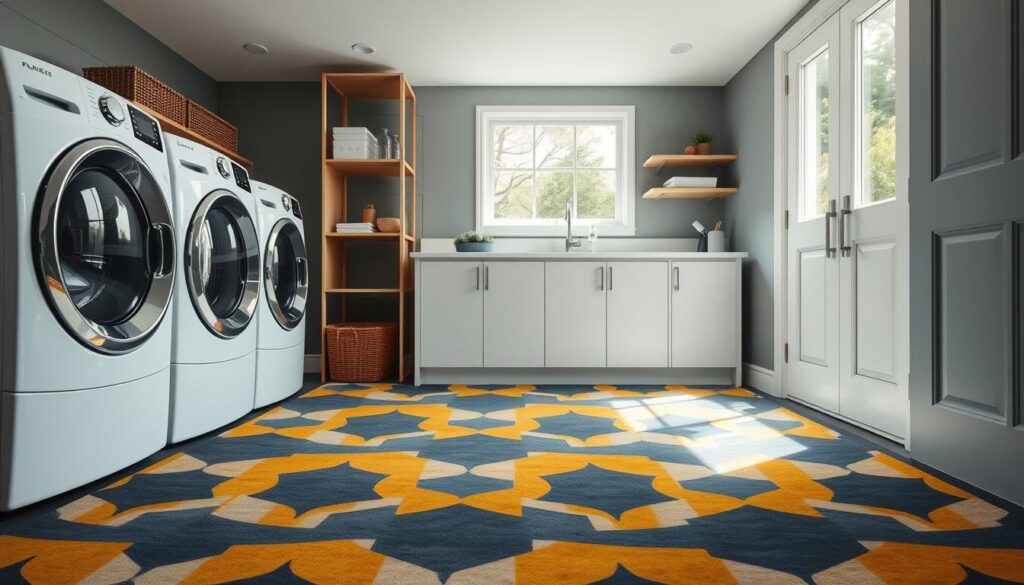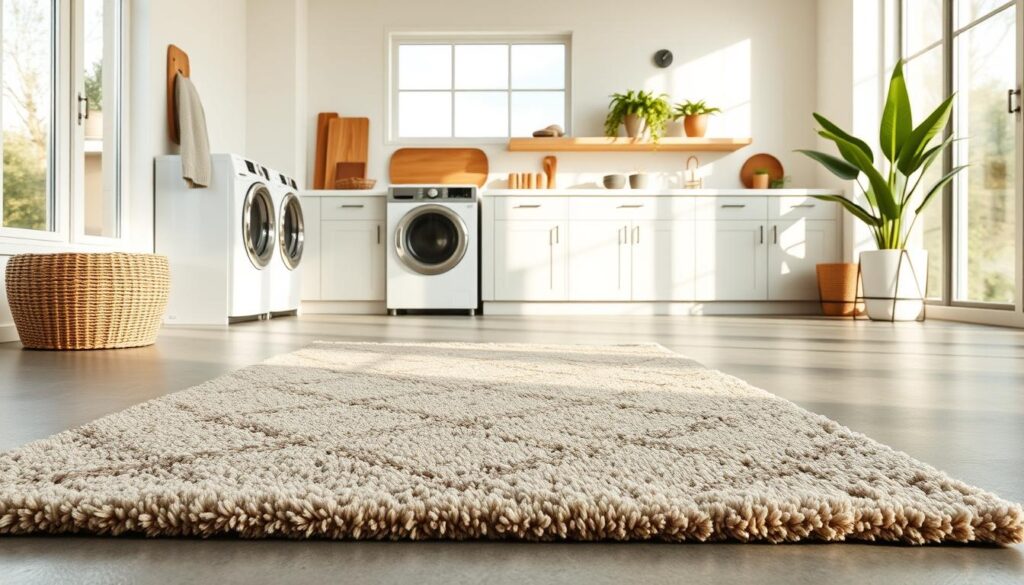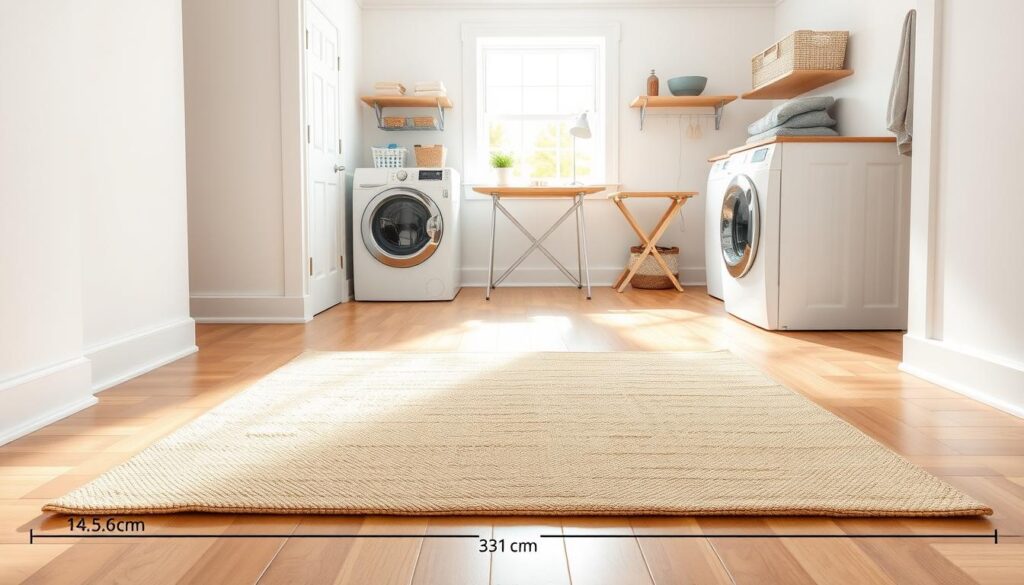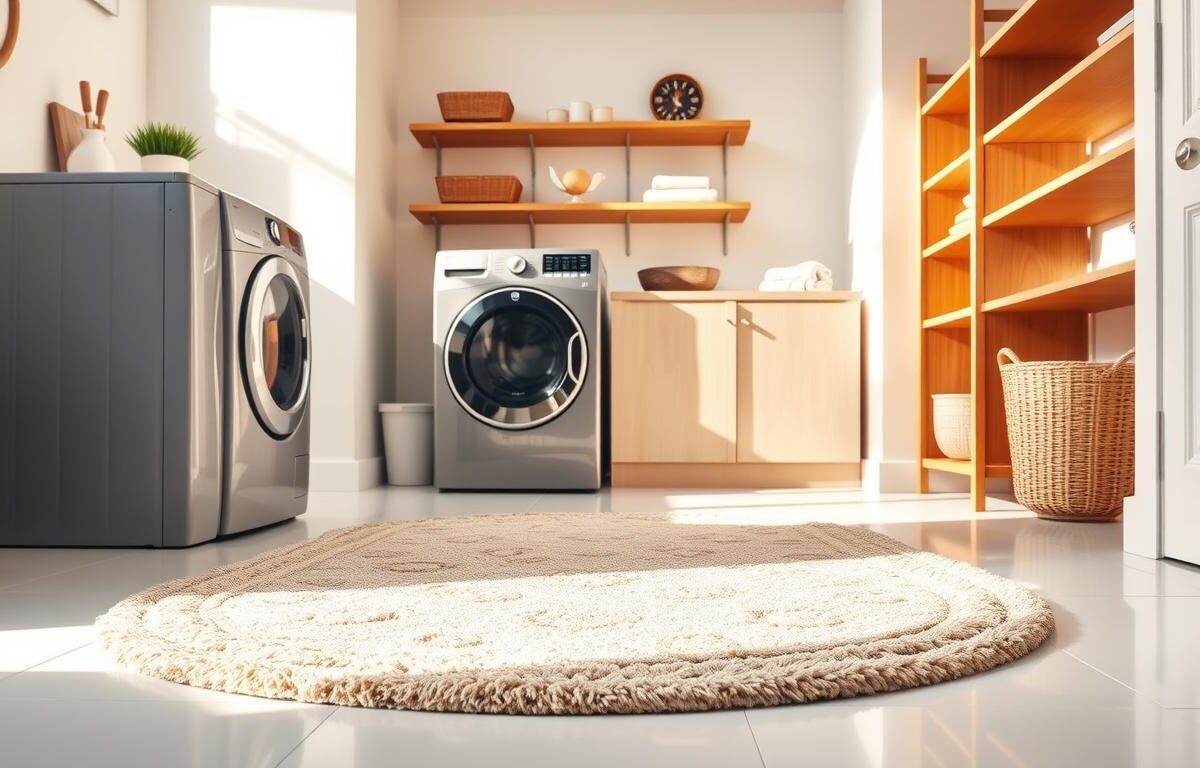Your home’s functional spaces deserve as much attention as your living areas. A carefully selected floor covering can turn a basic utility zone into a stylish extension of your personal aesthetic. Modern designs now prioritize both practicality and visual harmony, proving that even high-traffic areas can shine.
Durable materials like cotton-polyester blends or natural fibers offer protection against spills while adding comfort underfoot. Brands like Justrug and Miss Amara specialize in washable options that withstand daily use, with prices ranging from budget-friendly to premium. Whether you prefer minimalist patterns or bold textures, the right choice elevates your space effortlessly.
Size matters when balancing form and function. Compact layouts benefit from slim runners, while larger rooms can handle plush rectangular designs. Consider color schemes that complement cabinetry or appliances for a polished look. With free shipping and risk-free trials available, experimenting with styles has never been easier.
Key Takeaways
- Transform utilitarian spaces into inviting areas with intentional decor choices
- Prioritize moisture-resistant materials like polyester blends or jute fibers
- Measure your floor area to determine ideal rug dimensions
- Explore modern and traditional styles across 400+ design options
- Leverage free return policies to test rug suitability risk-free
Importance of a Laundry Room Rug
Every corner of your home tells a story, even the ones hidden behind chores. Utility zones like washing areas frequently become afterthoughts in design plans, despite their daily use. A simple floor covering bridges the gap between practicality and personality, turning overlooked spots into intentional spaces.
From Basic to Brilliant
Miss Amara designers highlight how the right mat transforms cluttered corners into cohesive extensions of your home. Their research shows 68% of users feel more motivated to complete chores in thoughtfully designed areas. Cushioned textures ease joint strain during long sorting sessions, while vibrant patterns distract from mundane tasks.
Safety Meets Serenity
Slip-resistant backings prevent accidents near washers, especially when handling wet items. Thick padding absorbs vibrations from appliances, reducing noise pollution. As one customer shared:
“It’s shocking how this small change made folding clothes feel like self-care time.”
Beyond physical perks, these additions create psychological wins. Walking into a cheerful, coordinated space makes daily responsibilities feel less tedious. Guests might never comment on your washing nook – but they’ll sense the care poured into every square foot.
Design Inspirations for Your Laundry Room
What if folding clothes became your favorite part of housework? The right visual elements turn chore zones into style statements. Today’s design revolution proves even functional areas deserve creative attention.
Energy Through Color Psychology
Sunny yellows boost productivity, while ocean blues create calming vibes. Rugette’s collection includes 97 blue options and 37 pink variations for instant mood lifts. Pair citrus tones with abstract shapes for a dynamic look that hides stains cleverly.

Timeless vs Trendsetting Choices
Traditional Persian motifs bring heritage charm, perfect for farmhouse aesthetics. Contemporary geometrics from Justrug’s Mediterranean line offer crisp modernity. One designer notes: “Your floor art should spark joy when you reach for detergent.”
| Style | Best For | Top Colors |
|---|---|---|
| Classic | Traditional homes | Burgundy, Navy |
| Modern | Urban spaces | Slate Grey, Mustard |
| Boho | Eclectic decor | Terracotta, Sage |
Don’t fear bold combinations – plum accents elevate neutral palettes, while black-and-white checks anchor colorful walls. The key? Choose pieces that make you smile during sock-matching marathons.
Enhancing Laundry Room Decor with Stylish Rugs
A well-curated space elevates daily routines from mundane to meaningful. Miss Amara’s globally sourced pieces blend artistry with practicality, featuring handcrafted patterns from Moroccan weavers to Balinese textile masters. These creations turn chore zones into cultural showcases – imagine folding towels atop a Turkish kilim or sorting socks beside African mudcloth motifs.

Justrug’s design philosophy proves floor coverings can be conversation starters. Their Mediterranean-inspired mosaics pair beautifully with subway tiles, while geometric patterns create modern contrast against stainless steel appliances. “Your mat should whisper ‘welcome’ every time you enter,” suggests lead designer Elena Rodriguez.
Consider these elements when selecting your centerpiece:
| Style | Inspiration | Best For |
|---|---|---|
| Mediterranean | Coastal villas | Bright, airy spaces |
| Contemporary | Urban lofts | Industrial layouts |
| Artisan | Global craftsmanship | Eclectic interiors |
Texture plays silent stylist – nubby wool adds cozy warmth, while flatweave cotton keeps things crisp. One homeowner shared:
“Our new rug makes the space feel like part of our living area, not just where we wash gym clothes.”
Your selection bridges utility and beauty. Whether choosing bold hues to energize mornings or neutral tones for serene evenings, let your floor art reflect what makes your home uniquely yours.
Selecting the Perfect Style and Size for Your Space
Balancing aesthetics and function requires precise measurements paired with creative vision. Start by mapping your floor plan – door swings, appliance placement, and workflow patterns all influence your ideal floor covering dimensions.

Measure Twice, Design Once
Use painter’s tape to outline potential placements. Leave 18-24 inches around appliances for smooth operation. Round shapes soften angular layouts, while runners streamline narrow pathways. Justrug’s design team advises: “Treat your floor plan like a dance floor – ensure every move flows naturally.”
Harmony Through Proportion
Scale your selection to complement cabinetry and wall colors. Bold geometrics add energy to neutral palettes, while subtle textures maintain minimalist appeal. Consider these popular configurations:
| Shape | Best Use | Brand Options |
|---|---|---|
| Round/Oval | Compact spaces | Rugette (592 styles) |
| Runner | Between appliances | Justrug Custom |
| Rectangle | Open layouts | Both brands |
One homeowner transformed their cramped utility area using a 90cm circular mat:
“It feels like the room gained square footage overnight!”
Thickness matters too – low-pile options work best under frequently opened doors. With Rugette’s 300cm+ options and Justrug’s customization, you’ll find solutions for any configuration. Let your space breathe while making every detail count.
Material Matters: Durable and Washable Options
What separates a practical floor covering from a problematic one in moisture-prone areas? The answer lies in fiber technology that laughs at spills and shrugs off humidity. Today’s top-performing fabrics combine industrial-strength resilience with home-friendly maintenance.
Moisture-Resistant and Easy-to-Clean Fabrics
PET fibers lead the pack with superhero-level stain resistance. Made from recycled plastic bottles, these synthetic strands repel liquid like ducks’ feathers. Miss Amara’s research shows their quick-dry capabilities outperform cotton by 73% in humid environments. Spilled detergent? Just wipe and go.
Cotton blends offer a softer approach without sacrificing durability. Justrug’s 70% cotton creations provide cloud-like comfort underfoot while resisting color fading. One user marveled: “It’s survived three kid-induced juice disasters – still looks new after machine washing!”
Eco-Friendly Choices: PET Fibers and Jute
Jute brings earthy charm with natural moisture control. Its coarse weave allows air circulation, preventing mildew growth behind appliances. Pair it with rubber backing for slip-free safety near washing machines.
For green-minded shoppers, PET options turn 12 plastic bottles per square meter into vibrant designs. These eco-warriors handle weekly washes without fraying – perfect for homes wanting sustainability that works as hard as they do.
| Material | Best Feature | Care Tip |
|---|---|---|
| PET Fibers | Stain-proof surface | Machine wash cold |
| Jute | Natural dehumidifier | Spot clean only |
| Cotton Blend | Hypoallergenic | Tumble dry low |
Practical Benefits and Added Comfort in High-Traffic Areas
Busy households need solutions that work as hard as they do. Rugette’s specialized floor coverings combine resilience with thoughtful engineering, designed for spaces where foot traffic never stops. Their innovative non-slip technology grips surfaces like polished concrete, preventing slips even when hands are full of damp towels.
Thick cushioning transforms standing sessions from tiresome to tolerable. One parent noted: “Sorting socks feels less like a marathon now – my knees thank me!” Low-pile designs strike the perfect balance, offering support without trapping pet hair or crumbs.
| Feature | Benefit | Ideal For |
|---|---|---|
| Reinforced edges | Prevents fraying | Frequent movement |
| Moisture-wicking | Dries quickly | Spill-prone zones |
| Antimicrobial layer | Reduces odors | Humid environments |
Hypoallergenic materials keep sneezes at bay, making these choices safe for sensitive family members. The secret lies in tightly woven fibers that block dust mites while remaining soft underfoot.
Durability shines through reinforced stitching and fade-resistant dyes. As one designer explains:
“Our mats endure 10x more footfalls than standard options without losing shape.”
Whether battling muddy paws or detergent drips, these workhorses maintain their charm through daily chaos.
How to Choose Your “laundry room rug”
Transform your utility zone into a space you love with smart choices that balance beauty and practicality. Start by assessing your daily needs – from foot traffic patterns to cleaning routines – to guide your selection.
Key Factors: Size, Material, and Design Details
Measure your floor area before browsing options. Leave 6-8 inches around appliances for easy access. Washable rugs with PET fibers handle spills best, while cotton blends offer softness. Miss Amara’s 360° viewer helps visualize patterns in your space.
Design details matter more than you think. Textured weaves hide lint, while dark borders camouflage shoe marks. One designer suggests: “Treat your mat like artwork – it should complement cabinets without matching exactly.”
Expert Tips for a Stress-Free Selection Process
Order multiple sizes to test proportions. Justrug’s free returns make this easy. Check pile height – low-profile options work under swinging doors. For homes with pets, choose rugs featuring organic shapes that disguise paw prints.
Remember: Your perfect match combines durability with personal style. With 400+ washable options across trusted brands, you’ll find floor coverings that turn chore time into a moment of quiet pride.

